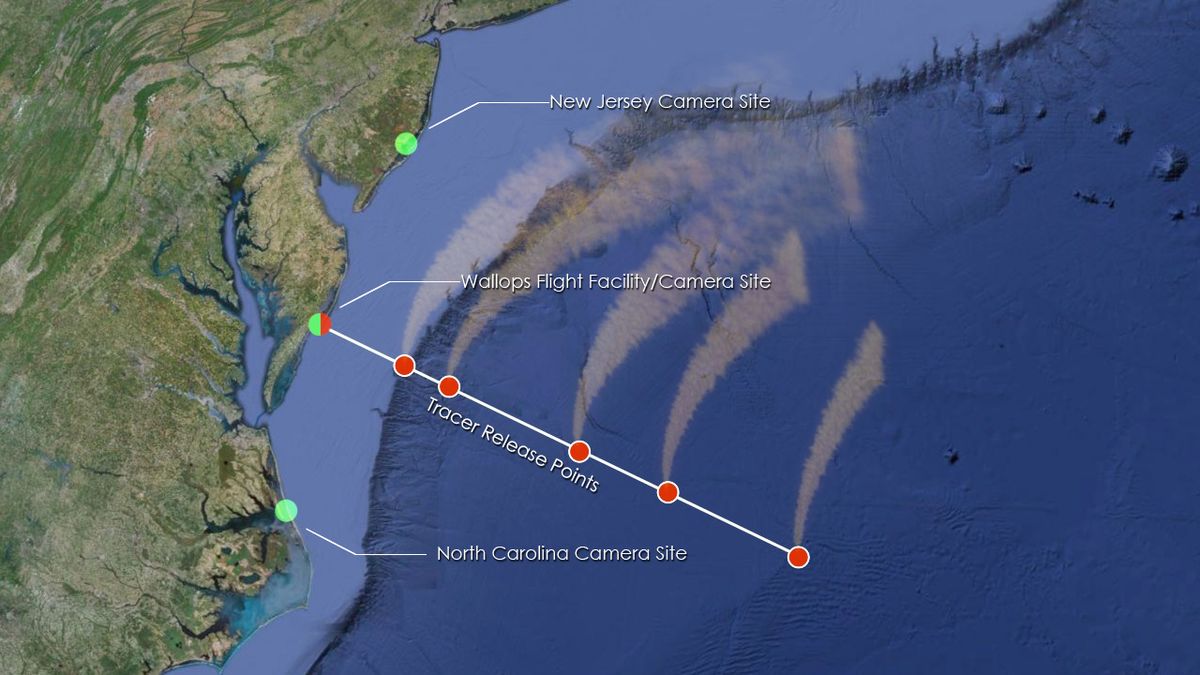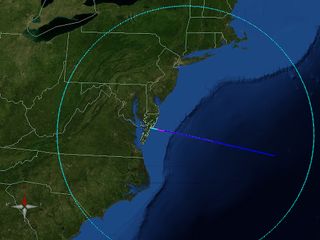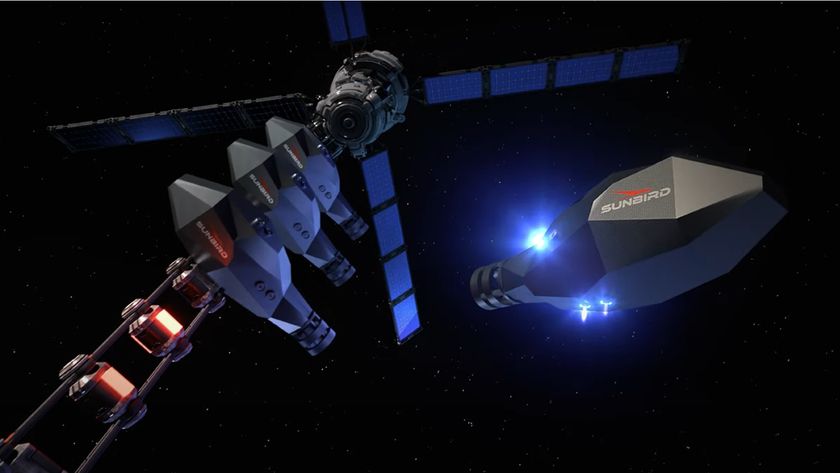NASA Launching 5 Rockets to Light Up US East Coast Sky Tonight

A quintuple rocket launch promises to put on a spectacular, but brief, overnight light show of luminescent vapor trails in the skies above the U.S. East Coast tonight, weather permitting. The sky display may puzzle and amaze some unsuspecting observers, so before you make that phone call to your local news or police, here is why this is happening and when you may see it.
The bright phenomenon will be caused by NASA's Anomalous Transport Rocket Experiment (ATREX), which will launch five chemical-bearing suborbital rockets in about five minutes to test the flow of winds and electrical currents at high altitudes. The rockets will blast off from NASA's Wallops Flight Facility on Wallops Island, Va., on the Atlantic coast during a window that opens tonight at midnight EDT (0400 GMT) and closes at 1:30 a.m. EDT Thursday (0530 GMT).
As part of the mission, the five rockets will each release a chemical tracer that should inscribe brilliant milky white trails in the nighttime sky and allow scientists and the general public to actually "see" high-altitude winds at the edge of space, according to a NASA description.

Midnight launch lights
If all goes well, NASA intends to photograph the trails from three different sites: Wallops Island, southern New Jersey and the outer banks of North Carolina. Should weather conditions be unfavorable, the firings will be delayed to another night, with alternate launch dates available between March 16 and April 3.
Three different types of sounding rockets will be used to create the five cloud trails: two Terrier Improved Malemutes, two Terrier Improved Orions and one Terrier Oriole. These small rockets are powerful enough to launch instruments off the planet on short flights, but not strong enough to reach orbit and circle the Earth. [Photos: NASA's ATREX Rocket Barrage Mission]
Each rocket will eject a stream of the chemical trimethyl aluminum (TMA) which will be illuminated at high altitudes by the sun (which will be below the local horizon at ground level). Initially, the clouds are expected to glow in reddish hues, then quickly turn to white, They could persist in the sky for as long as 20 minutes before fading completely away.
Sign up for the Live Science daily newsletter now
Get the world’s most fascinating discoveries delivered straight to your inbox.
The ATREX project is aimed at gathering information to better understand the processes responsible for the high-altitude jet stream winds located 60 to 65 miles (97 to 105 kilometers) above the surface of the Earth.
That works out to a potential viewing radius of up to 450 miles (725 km), suggesting that the resultant cloud trails might be glimpsed from perhaps as far north as southern Vermont and New Hampshire, as far south as the border of coastal North and South Carolina and as far west as central West Virginia.
The key to making a sighting is to have a clear, unobstructed view of the night sky horizon in the direction of Wallops Island. For example, a viewer in Raleigh, N.C. should look toward the northeast; in Providence, R.I., observers should face southwest; in Philadelphia, Pa., the view will be toward the southeast.
A gusty jet stream
Looking up along the trajectory from the ground, such trails often appear tangled in complex ways, sometimes resembling a corkscrew shape. Their distorted shape provides scientists with precise data on wind speeds and directions at various levels of the upper atmosphere. The jet stream between 60 to 65 miles above the Earth's surface is much higher than the one commonly reported in weather forecasts.
The winds found in this upper jet stream typically have speeds of 200 mph to well over 300 mph and create rapid transport from the Earth's mid-latitudes to the polar regions. This jet stream is located in the same region where strong electrical currents occur in the ionosphere. It is therefore a region with a lot of electrical turbulence, of the type that can adversely affect satellite and radio communications. In addition to the cloud tracer experiment, two of the rockets will have instrumented payloads, to measure the pressure and temperature in the atmosphere at the height of the high-speed winds. [Video: How NASA's ATREX Rocket Missions Work]
How to watch
There are several ways to watch NASA's ATREX mission launch overnight:
- NASA's Wallops Flight Facility Visitor's Center will open at 10 p.m. EDT tonight for local launch viewers. The center is located on VA 175 near Chincoteague Island, Va. Phone: (757) 824-2298 or 824-1344
- NASA will also provide a live webcast of the launch here: http://sites.wff.nasa.gov/webcast
- NASA updates on the mission are also available via Twitter @NASA_Wallops and on the launch center's Facebook page.
"We're Being Invaded!"
NASA used to conduct ion cloud experiments from Wallops Island much more frequently during the 1960s, '70s and '80s, usually in the predawn hours when most people were asleep. Along with trimethyl aluminum, other chemicals such as barium and triethylborane were used, often creating rather exotic colors of red, green and purple.
When such launches took place during convenient evening hours they usually took people by surprise. In March 1967, when three clouds were released at around 7 p.m., they were followed by countless numbers of people all along the East Coast calling newspapers and police stations, asking for explanations of the strange sightings.
One man described the rocket residue as "red balls of fire" at the time.
In January 1975, a barium cloud was released at around 5:30 p.m. in the evening. As luck would have it, the town of Riverhead, N.Y. was hit by a power outage at the very same time that the cloud appeared in the sky.
This resulted in a panic among the local residents who believed that the cloud had something to do with the loss of their power. According to accounts, one man called the local police station and shouted: "We’re being invaded! I can see the spaceship in the sky right now ... it's glowing with a greenish color and expanding as it’s draining us of our electric power!"
If you snap an amazing photo of the glowing clouds released by NASA's ATREX rockets, or any other sky object, and would like to share them with SPACE.com for a story or gallery, please contact managing editor Tariq Malik at: tmalik@space.com.
This story was provided by SPACE.com, a sister site to LiveScience. Joe Rao serves as an instructor and guest lecturer at New York's Hayden Planetarium. He writes about astronomy for The New York Times and other publications, and he is also an on-camera meteorologist for News 12 Westchester, New York.














